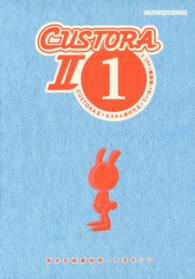- ホーム
- > 洋書
- > 英文書
- > Cinema / Film
Full Description
This is the first book to investigate the coming-of-age genre as a significant phenomenon in New Zealand's national cinema, tracing its development and elucidating its role in cultural change. With chapters on landmark films like An Angel at My Table, Heavenly Creatures, Once Were Warriors and Boy, this book explores the influence of the French New Wave and European art cinema, and examines the dialogue between national cinema and a nation's literature.
Looking at the characteristics of an indigenous "Fourth Cinema," as well as different perspectives on gendered and sexual identities, Coming-of-Age Cinema in New Zealand considers the evidence that these films provide of significant cultural shifts that have taken place or are in the process of taking place as New Zealanders' discover their emerging national identity.
Contents
Preface
Part 1. The Coming-of-Age Genre and National Cinema
Chapter 1. The Coming-of-Age Film as a Genre: Attributes, Evolution, and Functions
Chapter 2. New Zealand Coming-of-Age Films: Distinctive Characteristics and Thematic Preoccupations
Part 2. The New Zealand New Wave: 1976-1989
Chapter 3. The Formation of a Budding Man Alone: The God Boy (Murray Reece, 1976)
Chapter 4. An Angry Young Man Seeks to Justify Himself: Sleeping Dogs (Ian Donaldson, 1977)
Chapter 5. An Immigrant Filmmaker Substitutes an Alternative Vision of Adolescence: The Scarecrow (Sam Pillsbury, 1982)
Chapter 6. Art-Cinema, Cultural Dislocation, and the Entry into Puberty: Vigil (Vincent Ward, 1984)
Chapter 7. A Māori Girl Watches, Listens, and Learns - Coming of Age from an Indigenous Viewpoint: Mauri (Merata Mita, 1988)
Part 3. The Second Wave of the 1990s
Chapter 8. Creativity as a Haven: An Angel at My Table (Jane Campion, 1990)
Chapter 9. Desperation Turned Outwards: Heavenly Creatures (Peter Jackson, 1994)
Chapter 10. Confronting Domestic Violence and Familial Abuse: Once Were Warriors (Lee Tamahori, 1994)
Part 4. Preoccupations of the New Millennium
Chapter 11. An Adolescent Girl Experiments with Sexuality: Rain (Christine Jeffs, 2001)
Chapter 12. Asserting Feminist Claims within Maori Culture: Whale Rider (Nicki Caro, 2002)
Chapter 13. Family Secrets and Their Destructive Consequences: In My Father's Den (Brad McGann, 2004)
Chapter 14. A Gay Boy Comes to Terms with His Sexuality: 50 Ways of Saying Fabulous (Stewart Main, 2005)
Part 5. Perspectives on Māori Culture since 2010
Chapter 15. Parental Abandonment and the Trauma of Loss: Boy (Taika Waititi, 2010)
Chapter 16. A Māori Boy Contests the Old Patriarchal Order: Mahana (Lee Tamahori, 2016)
Chapter 17. Delinquency and Bicultural Relations: Hunt for the Wilderpeople (Taika Waititi, 2016)
Conclusion
Bibliography
Index








